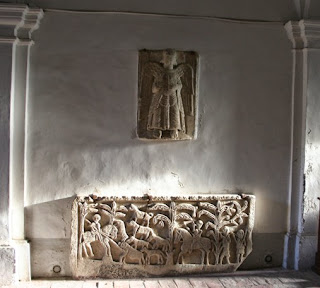My work trips to Rome seem to be every time huge whirlwinds of activity and experiences. This time it is even more so, since I have managed to pack into a week serious pottery work, meetings with Swedish and Italian colleagues, library work, two half days in Chris Wickham's Fest-do and finally a trip to Nepi to see the new communal museum. Every single part of the week has been interesting and eye-opening - even the one involving moving builders ladders and being covered in dust while passing the honourable bishops and representatives of religious orders in the Finnish Institute after a busy morning in the 'Archaeological Lab'.
An impromptu meeting with a Swedish colleague separated me from the wine reception in the BSR during the ChrisFest, but one has to grasp an opportunity when it knocks. This meeting saved us from Skyping or taking trains at a later stage, so running away before the prosecco was for the common good - or this I tell myself gritting my teeth. However, the two visits to the conference underlined the difference historians and archaeologists have. While archaeologists rarely part from their visuals and PowerPoints, the pure historians stick to reading their prepared texts. Not necessarily reflecting the general feeling, since after all, I missed two whole days of langobards and even Medieval Iceland, my highlights were the topographic memory at Cosa and Alatri as presented by Lisa Fentress and the talk on early Medieval gardens in Rome by Caroline Goodson. Both by archaeologists with nice images and maps together with PowerPoint slides on ancient text excerpts and, crucially, new ideas and information about appropriation and food security. Elsewhere in the conference there were also interesting details to be learned about the shortages of olive oil in the early Medieval world.
The short stays in the ChrisFest gave food for thought for Volterra and the trip to Nepi gave food for thought for the history of the wider region. Museum Director Stefano Francocci had already earlier asked me to visit the communal museum of Nepi, since I was not in Italy when the big opening took place a few years ago. Now he kindly changed his working hours and came to guide me and my Finnish historian colleague who specialises in Roman religion. Thus, after seeing the museum the exhibition, which is of unusual quality for a local, communal museum with both Italian and English texts and reconstructions and multiple displays stretching from the Orientalising cemeteries to Lucrezia Borgia, I asked about the possibility to visit the local catacombs of Santa Sevinilla. Stefano did come to guide us personally, which just shows his generosity.
The catacombs are small but well presented and since my earlier visit at the turn of the Millennium the church had been renovated and the area of the whole inside floor had been excavated. This had allowed to expose the original entrance to the inferior corridor and some graves on the rock surface. The catacomb dates to the fourth century AD and has also some Medieval paintings, so it has not really been totally forgotten. The stories about early martyrdom and other features are examples of the topographic social memory Lisa was talking about. The similar catacombs in Sutri, Bolsena and along Via Amerina (not open or available currently for visit) show the strength of the late Roman settlement in the small towns of the Viterbo region. My colleague Marja-Leena Hänninen was really pleased - especially, since afterwards we visited the cosmatic cathedral in Civita Castellana and saw reused sacrofagus as an altar, Roman inscribed tomb stones, Medieval sculpture, the crypts and the beautiful cosmatic floor and portico outside. After a busy week, a work trip was not really a work trip, but a pleasure with a friend.



No comments:
Post a Comment